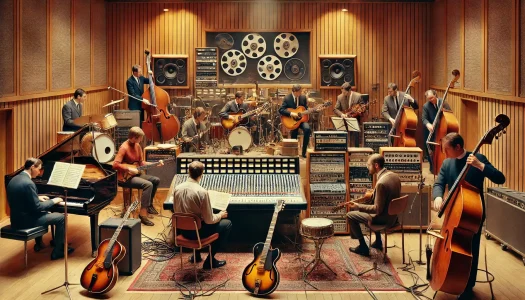Phil Spector was a music producer and songwriter. He became famous in the 1960s for making hit songs with a rich, full sound. Many people still see him as one of the most important figures in pop music. The “Wall of Sound” was his way of recording music to make it sound big and bold, even on small radios.
Origins of the Wall of Sound
Phil Spector developed the Wall of Sound in the early 1960s. He wanted to make songs that sounded strong and full, even on small speakers. Most people listened to music on AM radios or jukeboxes back then, where sound quality was poor. Spector saw this as a problem he could fix.
He was influenced by big band music, classical music, and the bold style of producers like Leiber and Stoller. He also learned a lot while working at Gold Star Studios in Los Angeles. That studio had a famous echo chamber, which helped him shape his sound.
Spector’s goal was to make records that felt like they filled the whole room.
Core Principles of the Wall of Sound
The Wall of Sound was built on four main ideas:
1. Large ensembles
Spector used many musicians playing the same parts at once. For example, he might record three pianos, two guitars, and several drums playing together. This made the music sound big and rich.
2. Layering and overdubbing
Tracks were recorded over each other many times. Spector would build up layers of sound to create depth and texture.
3. Echo and reverb
He used the echo chamber at Gold Star Studios to give the music space and warmth. The sound bounced off the walls, creating a deep, roomy effect.
4. Mono recording
Spector mixed his music in mono, not stereo. This gave him full control over how it sounded on radios and jukeboxes. He wanted every listener to hear the same thing, no matter the speaker.
Notable Recordings
One of the best examples of the Wall of Sound is “Be My Baby” by The Ronettes. The song opens with a powerful drum beat and layers of instruments. You can hear strings, guitars, piano, and percussion all blending into one strong sound. The echo adds space, making it feel larger than life.
Another key track is “You’ve Lost That Lovin’ Feelin’” by The Righteous Brothers. Spector used deep vocals, slow tempo, and heavy reverb to build emotion. The thick sound gives the song its dramatic feel.
These songs show how the Wall of Sound could turn a simple pop tune into something bold and unforgettable.
Impact on Music Production
The Wall of Sound changed how people made records. It showed that the studio could be used as an instrument. Many pop and rock producers began to build songs with more layers and effects.
Artists like Brian Wilson of The Beach Boys were deeply inspired by Spector’s sound. Wilson called “Be My Baby” his favorite record and used similar ideas in songs like “God Only Knows.”
Later producers, such as Bruce Springsteen and even modern pop hitmakers, kept using Spector’s ideas. Big sounds, strong emotions, and rich textures became part of mainstream music.
His legacy lives on in how songs are arranged, recorded, and mixed today.
Criticism and Limitations
While the Wall of Sound was bold and new, it wasn’t for everyone. Some critics said it was too loud or messy. With so many layers, the music could lose clarity. Individual instruments were hard to hear, and details got buried.
As music technology improved, artists wanted more control and space in their recordings. In the 1970s, many turned to cleaner sounds with less reverb and more focus on each part. Stereo became popular, offering a wider and clearer mix than mono.
These changes led some artists to move away from Spector’s style in favor of more open, dynamic production.
Closing Thoughts
Phil Spector changed the way people made and heard music. His Wall of Sound turned simple pop songs into rich, powerful recordings. By layering instruments and using echo, he created a sound that filled the room and left a lasting mark on music history.
Even though some moved away from his style, the impact stayed. Many producers still use his ideas to build emotion and depth in songs. The Wall of Sound remains a key moment in the story of modern music—bold, influential, and unforgettable.
